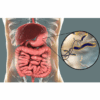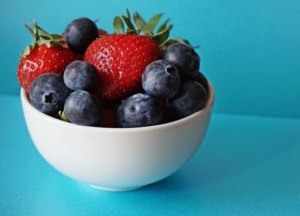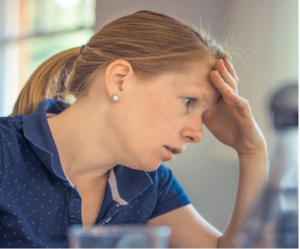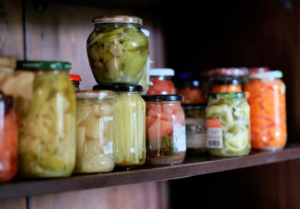
Introduction: Understanding the GLP-1 and Constipation Connection
GLP-1 receptor agonists have revolutionized treatment for both type 2 diabetes and obesity management. These medications—including popular brands like Ozempic, Wegovy, Mounjaro, and Zepbound—have gained widespread attention for their effectiveness in weight loss and blood sugar control.
And while these meds can be effective for both weight loss and blood sugar control, most patients experience digestive side effects, with constipation ranking among the most common complaints. Side effects can be significant enough that patients discontinue use of the meds, even when they’re seeing results.
So, let’s explore why GLP-1 medications cause constipation and how to manage this really uncomfortable side effect.
🎁 FREE DOWNLOAD GLP-1 Medications & Gut Health: Essential Tips – Grab it Here
What Are GLP-1 Medications?
Let’s take a step back and discuss what GLP-1 meds are so that you have a good understanding of how they work. GLP-1 receptor agonists mimic the action of glucagon-like peptide-1, a naturally occurring hormone that regulates blood sugar and appetite.
These drugs were initially developed for type 2 diabetes treatment, and these medications have now received FDA approval for chronic weight management in individuals with obesity or overweight with weight-related health conditions. The meds are the same active ingredients, but the dose for weight management is typically higher than that for type 2 diabetes treatment.
These medications work through several mechanisms:
- Slowing gastric emptying (delaying how quickly food moves from your stomach to intestines)
- Increasing feelings of fullness and appetite suppression
- Helping regulate blood glucose levels
- Helping reduce “food noise” and fear of being hungry
Popular GLP-1 weight loss medications include:
- Semaglutide (branded as Ozempic for diabetes, Wegovy for weight management)
- Tirzepatide (Mounjaro for diabetes, Zepbound for weight management)
- Liraglutide (Victoza for diabetes, Saxenda for weight management)
- Dulaglutide (Trulicity)
Why Do GLP-1 Medications Cause Constipation?
Constipation is reported in approximately 10-20% of patients taking GLP-1 weight loss drugs. It is typically dependent on the dose of meds you are taking, and in our practice, most patients do experience some degree of constipation.
Understanding the causes of constipation can help you manage symptoms:
1. Delayed Gastric Emptying
The primary reason you may experience constipation from Ozempic and other GLP-1 medications relates to their intended effect of slowing digestion. This delayed gastric emptying gives your body more time to absorb water from stool, potentially leading to harder, drier stools that are difficult to pass.
This stool can look like rabbit pellets or small pieces of stool, whereas the desired consistency of your poop is one long smooth snake. With constipation, stool is uncomfortable to pass and you just don’t feel great having stool feel like it’s stuck.
2. Reduced Food Intake
Many patients on GLP-1 weight loss medication significantly reduce their food intake due to decreased appetite. That’s the goal, right? But lower food volume means less bulk moving through the intestines, which can further slow transit time and contribute to constipation symptoms.
Additionally, when your appetite is reduced, it’s likely that you’re not getting your goal 25 – 30 g of fiber each day. It’s difficult to do when you’re simply not eating as much food. Eating fewer high fiber foods means constipation is more likely.
3. Increased Dehydration Risk
Some patients experience nausea while taking Wegovy, Ozempic, or Mounjaro, and no one wants to guzzle water when they feel queasy. GLP-1 meds can also cause a general reduced desire to drink. Both of these conditions can lead to inadequate hydration—a key factor in preventing constipation.
4. Altered Gut Motility
GLP-1 drugs can affect the natural contractions of intestinal muscles that move stool through the digestive tract, further contributing to digestive side effects. The upper portion of the stomach, located closest to the esophagus, is more relaxed and the muscle at the end of the stomach that controls the flow of food into the small intestine (pyloric sphincter) is more “toned” in patients taking GLP-1 meds. The result is that the stomach empties more slowly.
Recognizing Constipation Symptoms While on GLP-1 Medication
It seems pretty clear, right? You know if you’re constipated or not. But besides simply not pooping regularly, constipation from semaglutide and other GLP-1 medications can present as:
- Fewer than three bowel movements per week
- Hard, dry, or lumpy stools
- Straining during bowel movements
- Feeling of incomplete evacuation
- Abdominal discomfort or bloating
- Hard stool followed by watery loose stool
It’s important to distinguish between occasional constipation (which is common) and chronic constipation, which may require assistance to address the cause.
Managing Constipation While on GLP-1 Weight Loss Drugs
Dietary Approaches for Constipation Relief
- Increase Fiber Intake Gradually: Aim for 25-30 grams of dietary fiber daily from sources like:
- Fruits (berries, apples with skin, pears)
- Veggies (broccoli, carrots, leafy greens)
- Whole grains (oats, rice)
- Legumes (beans, lentils, chickpeas)
However, increase fiber intake slowly to avoid bloating and gas.
- Stay Hydrated: Drink at least 64 ounces (about 2 liters) of water daily. Warm liquids, particularly in the morning, can stimulate bowel movements. Some people swear by warm water with a little squeeze of lemon first thing in the morning to get things going.
- Consider Fiber Supplements: We prefer that our GLP-1 patients get their fiber from food, but sometimes that just isn’t enough. There are many fiber options on the market, but we prefer resistant starch as a super gentle, well-tolerated source of fiber to relieve constipation. Find our favorite resistant starch supplement here, with our discount. Other options include psyllium husk, methylcellulose, or other soluble fiber supplements can also help relieve constipation, but they may be more likely to cause bloating, gas, or other GI symptoms. With all fiber supplements, increase your intake of water to keep things moving smoothly.
- Incorporate Probiotic Foods: Yogurt, kefir, sauerkraut, and other fermented foods may help maintain healthy gut bacteria balance and improve digestive health. In fact, we love fermented foods for all our patients dealing with gut health symptoms. (Find our recipe for Fermented Ginger Applesauce here.) In our practice, we see that patients that eat a few spoonfuls of fermented foods daily have a much better beneficial bacteria profile than those that don’t include fermented foods at all.
Lifestyle Modifications for Constipation Management
- Regular Physical Activity: Even moderate exercise like daily walking can stimulate bowel function and improve motility, helping to prevent constipation. We always suggest that patients start with walking if they’re not already active because it requires zero new gear and it’s accessible to most people. Start with 10 minutes and day and work your way up. Bonus points if you walk after meals.
- Establish a Bathroom Routine: Try to have bowel movements at the same time each day, preferably after meals when the gastrocolic reflex is strongest or first thing in the morning.
- Don’t Ignore the Urge: A bathroom routine is awesome, but don’t hold it just because it’s not “time” for you to go. It stands to reason that going when you feel the urge to have a bowel movement helps prevent constipation symptoms.
- Proper Toilet Posture: Using a footstool or a squatty potty to elevate your knees above your hips can help align the rectum for easier passage of stool.
This really works to get things moving without straining!
If you don’t have a footstool that you want to just leave in your bathroom, we suggest using the bathroom trash can as a way to prop up your feet. Works wonders when you’re out in public as well.
Over-the-Counter Solutions for GLP-1 Related Constipation
If dietary and lifestyle changes aren’t sufficient for treating constipation while on GLP-1 medications, you can’t just let stool hang out in your colon. Even in patients NOT taking GLP-1s, we see that slow motility can lead to dysbiosis (imbalance of harmful to beneficial bacteria) or SIBO (small intestinal bacterial overgrowth). You do not want that!
Our first suggestion would be to add a magnesium glycinate and/or triphala powder supplement to your daily routine and see if these will allow the GI tract to relax enough to have more regular BMs. If not, you may wish to discuss these options with your healthcare provider:
- Osmotic Laxatives: Products containing polyethylene glycol (Miralax) draw water into the intestines and can be safe for regular use.
- Stool Softeners: Docusate sodium (Colace) helps increase water absorption in the stool.
- Magnesium Supplements: Magnesium citrate or magnesium oxide can help relieve constipation, but use with caution as they may interact with certain medications.
- Stimulant Laxatives: Products containing senna or bisacodyl should be used sparingly and only short-term as they can create dependency.
When to Consult Your Healthcare Provider About GLP-1 Side Effects
While constipation from GLP-1 medications is common, certain symptoms warrant medical attention:
- Severe abdominal pain
- Blood in stool
- Unexplained weight loss, hard to tell when you’re on GLP-1s though
- Constipation that alternates with diarrhea
- Symptoms that persist despite lifestyle changes and over-the-counter remedies
- Constipation that begins suddenly and represents a significant change
Your healthcare provider might:
- Adjust your GLP-1 medication dosage
- Recommend prescription medications for constipation
- Evaluate for other potential causes of constipation
- Consider temporarily pausing treatment if symptoms are severe
Balancing Benefits and Side Effects of GLP-1 Weight Loss Drugs
For many patients, the benefits of GLP-1 medications for weight loss or diabetes management outweigh the inconvenience of constipation. The good news is that constipation often improves as your body adjusts to the medication, typically within a few weeks to months.
Finding the right balance of fiber, hydration, physical activity, and possibly supplements can help manage GLP-1 side effects while you continue to receive the therapeutic benefits of your medication.
Conclusion: Effectively Managing Constipation on GLP-1 Medications
Constipation from Ozempic, Wegovy, Mounjaro, and other GLP-1 receptor agonists is a common side effect, but it doesn’t have to detract from the positive impacts these medications can have on diabetes management and weight loss. By understanding why constipation occurs and implementing proactive strategies to prevent and manage it, most people can find relief while continuing their GLP-1 treatment.
Remember that each person’s body responds differently to these weight loss medications, and what works for one person may not work for another. Be patient with your body as it adjusts, and maintain open communication with your healthcare provider about any persistent or concerning symptoms.
With the right approach, the journey with GLP-1 medications can be more comfortable and successful in helping you reach your health goals, but don’t wait until you’re struggling with side effects.
Download your free Tip Sheet today and start your GLP-1 journey with confidence.
Gut Health Diagnosis at EverVital Nutrition
Are you struggling with side effects of GLP-1 meds like “Ozempic face” (read about what that is here), diarrhea, constipation, cramping, or bloating?
We can help!
At EverVital Nutrition, we use specific diagnostic tools to determine your level of gastrointestinal overgrowth, digestive function, and inflammation. It’s a comprehensive gut microbiome test, rather than a guess.
To learn more about gut testing and get on the path to healing so you can keep the weight off and better manage side effects like constipation, bloating, gas, or Ozempic Face, contact us for a free gut health assessment today.












Temp Mail Plus
Your blog is a breath of fresh air in the crowded online space. I appreciate the unique perspective you bring to every topic you cover. Keep up the fantastic work!
Donna Monthei
Thank you so much! I’m so glad you’re finding benefit!